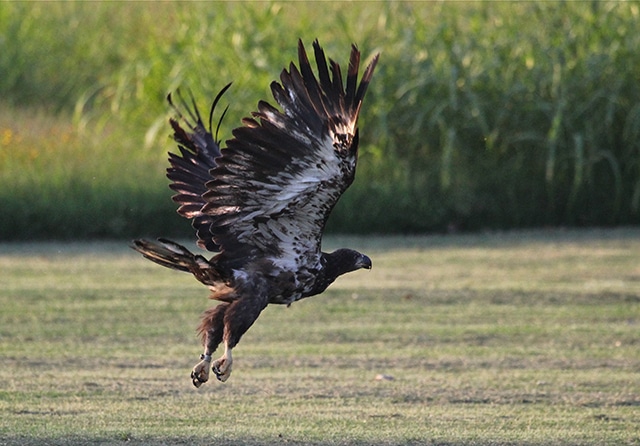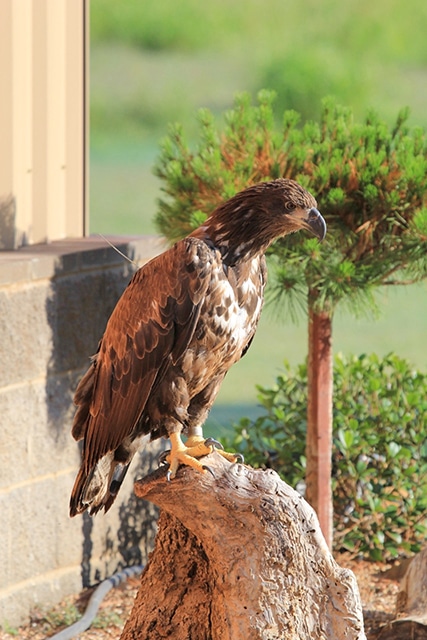 Time flies it seems. On April 16, 2015, 730 days will have passed to mark two years since Wadasé’s release. She has surpassed all expectations as we continue to learn valuable information from her telemetry.
Time flies it seems. On April 16, 2015, 730 days will have passed to mark two years since Wadasé’s release. She has surpassed all expectations as we continue to learn valuable information from her telemetry.
Many experts in the field marvel at the incredible amount of data gathered and her continued progress. With flights reching heights above 9,000 ft. (1.7 miles) and speeds over 55 mph, it is safe to say Wadasé has mastered the sky. She is able carry our prayers to the Creator, Mamo-Gosnan, and for that we are grateful.
Below is a recap of some of the highlights from the past two years’ progress.
In June of 2012 the Citizen Potawatomi Nation Eagle Aviary received a juvenile bald eagle originally from the Florida Audubon Society. Many people know this eagle as Wadasé and have watched her progress for the past two years as she continues to explore Pottawatomie County.
Long before she was Wadasé Zhabwé, CPN staff knew her as Penojés. Discovered near her nest in Orange County, Fla., she arrived at the CPN Eagle Aviary when she was approximately five months old where she was given the Potawatomi name, Penojés. She had suffered an injury to her left wing, including a fractured wing tip, extensive tissue damage and loss of her primary flight feathers.
The CPN Aviary staff planned to glove-train the young eagle and use her as an educational bird for students and Tribal members.

Wadase outside the enclosure.
“When we received her we didn’t believe that she would ever fly again,” said Jennifer Randell, CPN Eagle Aviary manager. “At that time, we felt she would make a great educational bird. We didn’t have a separate mews for her then and decided to put her in the enclosure with the other eagles.”
However, she began to fly when those missing flight feathers grew back and it was clear her non-releasable status needed to be reevaluated. By fall 2012, it was determined that Penojés had regained flight ability well enough to consider release back to the wild.
Penojés was cared for and rehabilitated by several experts in the aviary field. During the course of several months she learned to hunt and regained her strength and conditioning for flight. On April 16, 2013 she received a new Potawatomi name, Wadasé Zhabwé, meaning “Brave Breakthrough.”
Wadasé was banded and released with a tracking device so that aviary staff could monitor her progress.
Citizen Potawatomi Nation, the United States Fish and Wildlife Service, the Raptor View Research Institute of Missoula and Comanche Nation Sia all joined together to rehabilitate Wadase and were prepared to release and track the juvenile bald eagle. The CPN Aviary became the first ever Native American Aviary to release an eagle back into the wild banded and fitted with a GPS telemetry backpack. “That backpack gave us the confidence to release her knowing we could monitor her progress and intervene if she should have problems adjusting in the wild,” said Randell. “We never imagined the incredible amount of data we would be able to gather.”
Over the past two years the backpack has logged over fourteen thousand GPS points containing data such as location, speed, direction height, and temperature. While she has remained in Oklahoma since her release, she continues to explore new parts of the state, visiting nearly a third of its 77 counties. The closest she came to leaving the state was to the north just 7.5 miles from the Kansas border near the Great Salt Plains Lake. Her furthest trip south followed her discovery of the Washita River near Lindsay, which she followed to her westernmost point past Ft. Cobb stopping just short of Carnegie. To the east she has only gone as far as Okmulgee. Although she has never been more than 130 miles from the aviary since her release, she has logged thousands of miles flying as she ventures afield.
During the month of March 2015, Oklahoma experienced some of the worst winter weather of this season and for the first time since her release, Wadasé didn’t return to the aviary. During inclement weather she would normally arrive at the aviary just before the storm and would remain until the weather improved. She was better at forecasting the weather it seemed than our local weather station. But the recent storms came with heavy winds, snow and ice while she remained on the Washita River in the southwest portion of the state. She has been along the Washita almost two months now, except for one brief afternoon visit last month before returning to the same area just east of Chickasha. The first year of her release we saw her 146 days at the aviary. This past year that number was cut in less than half. She has become completely independent and proved that she is not just sustaining herself but she is thriving in the wild.

Wadase perched in her favorite pecan tree next to the aviary.
Rob Domenech from the Raptor View Research Institute equipped Wadasé the GPS backpack commented on her progress.
“I would have to say she is doing great. If you get a year of data you can’t complain. Anything after that is a bonus. Wadasé has proven herself to be a survivor and I am optimistic she will continue to do well, giving important glimpses into the details of her life.”
“We couldn’t be more pleased with that bonus data,” added Bree Dunham, CPN Eagle Aviary Asst. Manager. “It is humbling that Wadasé has allowed us to share so much space and time with her since her release but it seems from this point forward we will have to rely on the GPS with her visits being less frequent.”
The aviary staff will continue to monitor her progress and look forward to the coming year. “We hope to see if she follows the same trends and visits the same areas in the coming year,” said Randell. “We hope to have the opportunity to follow her until she begins nesting in the next few years. Perhaps then we could follow her fledglings and continue to tell her story for generations to come.”
The CPN Aviary staff would like to once again extend a sincere thank you to all of those involved in making this release not just a possibility but a success. From the good Samaritan who brought her to the Florida Audubon Society for treatment, to the dedicated staff who cared for her there, Sia: The Comanche Nation Aviary who assisted with her release, Rob Domenech from the Raptor View Research Institute who came all the way from Montana to fit her with telemetry and band her, to the CPN for the support of this program, the United States Fish and Wildlife Service for their efforts and to all the individuals who follow her story and keep her in your thoughts and to those close enough to keep an eye out for her here in Oklahoma.
Without all these people coming together this release would not have been possible. Please continue to keep an eye on the skies as Wadasé Zhabwé ventures into new areas of the state.
The many reports of sightings throughout state have played an intricate part in monitoring her success. To follow her movements with us you can visit www.arcgis.com/home and search for “Potawatomi eagle.” Send your encounters with Wadasé or any other eagles in the state or wherever you may be to jennifer.randell@potawatomi.org.
For more information or to read previous updates please visit https://www.potawatomi.org and search the site for Wadase or visit https://www.potawatomi.org/about-wadase
